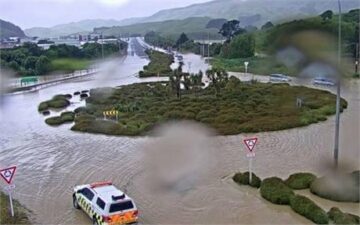In particular, the article is focused on whether existing surplus units held in private accounts will be sufficient to keep prices dampened throughout the 2020s before increased supply from forestry arrives in the ~2030s. To understand this, the article steps through:
-
What we know about present-day and medium-term price dynamics.
-
How long the NZ ETS can survive off surplus units without triggering the auction’s cost containment reserves (CCR).
-
The factors that could push back when the surplus is drawn down to zero.
-
What this means for the Government’s response.
Two issues have been the running focus of commentary on the NZ ETS over recent years.
First, there is currently a large number of units held in private accounts that are ‘surplus’ (i.e., that don’t have a clear purpose). This surplus has been well covered by both market commentators (Cowie, 2021) and the Commission (2024) themselves. The Commission’s new estimates of the surplus place it within a range of 50.8 to 84 million units. If accurate, this would be enough to cover 2–3 years worth of emission surrenders. It is no wonder then why spot-market prices remain hovering around the auction price floor, and why all four auctions in 2023 failed to clear. The recent finish of the 2018–2022 Mandatory Emissions Return Period (MERP) for foresters has undoubtedly added to this glut of supply.
Second, analyses by both government departments (MPI, 2022; MfE, 2023) and the Commission (2023a) have painted a picture of abundant supply from forestry in the medium-term. If true, this increased supply will dampen unit prices in the 2030s, likely settling around the long-run marginal cost of permanent exotic forestry. Recent estimates by Manley (2023) put carbon prices needed for production forests to make a cost-effective switch to permanent carbon forestry on most sites at around $50-$100 as a rough ballpark. These predictions of abundant forestry supply in the medium-term have rested on three basic premises:
-
There is abundant low-cost land available for conversion to forests in New Zealand.
-
Exotic afforestation is cost-effective at prevailing carbon prices. In contrast, many gross emission reduction opportunities are price inelastic.
-
Few laws at the regional or national level exist to slow-down conversion of land to forestry. Nor are practical constraints (e.g., nursery capacity) immutable.
However, these predictions haven’t come without their critics. With parts of New Zealand’s forestry sector and Māori forestry interests among the most critical voices. To be sure, there is validity to their critiques as well. In particular, the simplified relationship between carbon prices at the time of afforestation and subsequent rates of afforestation that is included within the Government and Commission’s models misses a wide range of factors that go into forestry investments. Most notable of which are long-term carbon returns, which are likely to be seen by foresters as a particularly uncertain variable at present.
Nevertheless, the basic economics of afforestation would suggest forestry will continue to grow as a form of net supply, and will likely play an outsized role on medium-term NZ ETS prices. Though with some uncertainty about the timing for when this shakes out.
Pending government decisions may also play a role in how soon we see abundant forestry supply. For example, we are yet to see whether and how the Government will act upon restrictions on afforestation by Land Use Capability (LUC) class as set out in the National Party’s election commitments. Likewise, the Government’s response to the 2023 consultation on the permanent forest category remains unclear, but is of enormous significance to NZ ETS unit flows in the long-term.
So I’ve covered the issues facing the NZ ETS today and in the medium-term. Issues many readers will have some familiarity with by now. But questions remain. What will the price path between these time horizons look like? And how aggressive is the Commission’s approach to drawing down surplus units?
The Commission’s intent to take an aggressive approach to surplus drawdown should be immediately clear. This is acknowledged by the Commission themselves, who note that (2024, p. 16) “based on our estimate of the increase in the surplus this year, we are recommending unit limit levels that reduce auction volumes significantly”. Likewise, the Commission’s stated aim (p. 48) “to reduce the surplus to zero by 2030” remains a crucial driver of their recommendations.
To dig deeper, this section examines the implications of the Commission’s proposed structuring of auction volumes between its two cost containment reserves (CCR) and units available above the auction price floor for surplus drawdown rates and prices in the NZ ETS.
Currently, auction volumes are split into three pools. First, a general pool of units is available above the auction price floor ($64 in 2024), with 14.1 million units available in this pool in 2024. However, for additional units to be sold, bidding must reach the CCR trigger prices, with the CCR split between two pools. In 2024 for example, an extra 2.8 million units are available if bidding reaches $184, and a further 4.9 million units above $230. It stands then that if the market needs to draw down the CCR pools to cover demand over the next few years, prices will have to rise significantly from those seen to date in the NZ ETS.
With those basics in mind, I now turn to examining whether combined supply from the surplus, industrial allocation and auction volumes available below the CCR will be enough to cover possible demand throughout the 2020s. Figure 1 below attempts to illustrate this by comparing supply from auctioning and industrial allocation against net emissions demand. Net emissions demand in this figure is formed from the Commission’s ‘current policy reference’ scenario for NZ ETS gross emissions, combined with forecast forestry removals from MPI. Both components roughly reflect carbon prices today continuing out into the future.
 |
| Figure 1: Unit supply available without triggering CCR compared against net emissions demand at present day (~$50) carbon prices. Notes: For details on the assumptions underlying figures, see the technical notes at the bottom of this article. |
For the period 2024–2029, a large year-on-year gap between net emissions and supply exists, averaging 18.6 million units per annum. This gap is in part an intentional play by the Commission, whose strategy has focused on use of under-supply to draw down the surplus. However, the extent of the gap also reflects the glut of forests planted in the mid-1990s registered on stock change accounting that are set for harvest over the next few years, and relatively low afforestation rates during most of the 2000s and 2010s (representing active growing forests).
Given the ongoing gap between net emissions demand and supply, the next factor that needs to be examined is what this means for possible surplus drawdown rates. Figure 2 below illustrates the level of net surplus each year if the CCR is not triggered. Each of the Commission’s low (50.7 million units), central (67.8 million) and high (84 million) estimates of current surplus volumes are illustrated as starting points.
 |
| Figure 2: Net surplus after surrenders (31 May) for preceding emissions year if CCRs not triggered. |
While the time at which the surplus is drawn down varies between each starting estimate, all three scenarios see the surplus fully drawn down by the 2026–2027 surrender year if the CCR is not triggered. This raises questions about the consistency of the Commission’s past statements (2023b, p. 11) that the CCR “is intended to be used only rarely” with its proposed structuring of auction volumes.
The illustration of the surplus drawdown in Figure 2 above is somewhat stylised however. In reality, the market may reduce the gap between net emissions demand and unit supply and push back the date at which the surplus is drawn down through a range of actions generally linked to rises in carbon price. These include:
Gross emissions:
-
Reducing gross emissions.
Forestry:
-
Increased afforestation.
-
Reduced deforestation.
-
Converting production forests to permanent forests.
-
Delaying harvest for production forests.
-
Registering existing forests outside the NZ ETS (including potentially converting these to permanent forests).
-
Avoiding use of Voluntary Emissions Returns (VERs) for harvested forests.
Eliciting further supply:
-
Release of non-surplus units held in private accounts.
-
Triggering the CCR.
The relative significance of these actions for closing down the gap between net emissions demand and supply are now discussed in turn.
Gross emissions opportunities to close the gap
There is reason to think that gross emissions reductions may play a relatively minor role in closing down the gap between supply and net emissions demand over the next few years. Differences between gross emissions reductions achieved through the Commission’s ‘demonstration pathway’ (that features a rising carbon price path that reaches ~$150 by 2030 and additional policies and measures outside the NZ ETS) and its ‘current policy reference’ scenario (featuring a stable ~$50 carbon price) are minimal in the mid-2020s Though with differences between these pathways more apparent in subsequent decades.
This can be seen in Figure 3 below, which illustrates the change in surplus per year for both gross emissions pathways. Each pathway for gross emissions sees roughly equivalent timing for surplus drawdown. However, this gap continues to grow to a 23.8 million unit difference in net surplus by mid-2030 (after surrenders for the 2029 emissions year).
 |
| Figure 3: Net surplus after surrenders each year compared between gross emissions reductions for ‘current policy reference’ and ‘demonstration pathway’ scenarios. |
Forestry opportunities to close the gap
Increased afforestation and reduced deforestation may play a slight role in reducing the gap between net emissions demand and available supply. However given slow growth rates of new forests and lead times needed to plan new afforestation, any new afforestation generated beyond existing central projections prepared by MPI (that see ~40,000ha planted per annum) will not shift the needle much over the next 2–5 years for net emissions demand. Likewise current political conditions are likely to inhibit near-term investment in afforestation. Factors cited for this uncertainty include the 2023 ETS Review, advice from the Commission advocating a fundamental change to the terms that forestry participates under within the NZ ETS, and the National Party’s manifesto commitments to limit Land Use Capability (LUC) classes that forests may be planted on.
Deforestation meanwhile remains at relatively low levels. It is also unclear how responsive future deforestation will be to changes in carbon prices, with recent deforestation due to conversion to higher-value land uses such as dairy and horticulture, or housing, infrastructure, schools, marae, roads, and lifestyle blocks.
It is more likely that plucky operators seeking to take advantage of any pending scarcity will investigate either converting production forests to permanent carbon forests, delaying harvest for existing forests or registering existing forests outside the NZ ETS.
However again, there are reasons to be sceptical on the flexibility of the market to pursue these. For conversion of existing mature production forests to permanent, this approach requires significant up-front financing by carbon forestry companies to take advantage of any short-term scarcity. This is because these companies must pay the existing landowner to forgo harvest revenue to be able to convert the forest to a permanent forest and take advantage of market dynamics within the next few years. In some sites where harvest is not economic, it may be possible to structure contracts so that the existing owner walks away with existing earnt units, however this type of land will only represent a portion of registered forests (and would still require sizable time, labour and legal resources to execute to a market-moving degree).
Carbon forest companies may seek to reduce this upfront cost by seeking contractual arrangements with landowners where they allow the existing production forest to be harvested, before assuming control of future units earned on the replanted forest. However, in this arrangement, net-flows of units over the next 5-years will closely resemble what would have occurred if the forest had just remained a production forest (making little difference to the estimates in this article).
Registering existing forests outside the NZ ETS is likely to remain fairly case-specific in future, owing to the need for the company pursuing this strategy to negotiate a multitude of contracts with existing forest owners. The recent removal of the stock change category is also likely to curtail the attractiveness of this approach.
Further it is likely that there is already a portion of landowners that have pursued this strategy of registering forests in the NZ ETS and converting these to permanent carbon forests in recent years. Landowners who now stand poised to reap any rewards over the next few years. This is evident through the rush of registrations leading up to the closure of the ability to register under stock change accounting at the end of 2022. However, this rush is already factored into the Commission’s estimates of the current surplus and government forecasts of forestry removal flows (which assume a portion of forests in the NZ ETS are permanent carbon forests).
For forest companies looking to delay harvest, the decreased value of over-sized logs, labour availability, management constraints related to the harvesting of large areas of forest, and existing contractual arrangements with mills or importers are likely to inhibit the ability to pursue this strategy. Likewise, this strategy carries a sizable degree of risk if the anticipated swings in unit prices are guessed wrong, given the need for foresters to surrender corresponding units at harvest.
Linked to this approach is avoidance of use of Voluntary Emissions Returns (VERs) by foresters harvesting over the next few years. While this practice is likely to shake out (meaning forestry’s net emissions demand is likely to be fairly clumpy either as relatively large net demand or supply at the end of the MERP), the short length of the current MERP (2023–2025) means noise from avoidance of VERs shouldn’t affect the overall picture of surplus drawdown.
Eliciting further supply from the CCR or private accounts
Next, I turn to the liquidity of units outside those that are classified as ‘surplus units’ within the pool of 160.8 million units currently in private accounts. In particular I ask, if these are able to be purchased and used over the next few years, could these be sufficient to ride out possible impending scarcity?
The Commission generally classifies these non-surplus units held in private accounts as either those set aside for hedging, pre-1990 allocation units, and units held by post-1989 stock change foresters for future surrender liabilities.
The Commission’s recent advice places units available for hedging at 19.8 to 36.6 million units. While full deployment of these hedged volumes over the next few years would push the point at which net surplus volumes reach zero out by up to a year or two, it is hard to see this being sufficient on its own to ride out pending scarcity until greater forestry volumes fully arrive in the 2030s.
For pre-1990 forest allocations, 16.2 million units are currently held in private accounts. This again may only go some way to riding out scarcity, given these are likely to be constrained by low willingness to part with units by some landowners. This can be due either to a lack of awareness that the landowner holds units, a desire to maintain land use flexibility, or desire to hold these as a long-term investment. The Commission’s workings also reflect this lack of willingness to sell, with their estimate of pre-1990 units available to be sold by the end of the decade ranging from 6.1 to 8.5 million units.
The final pool of non-surplus units held in private accounts are post-1989 forest units held for future harvest liabilities. The Commission’s advice puts this range at 51 to 65 million units currently. Portions of this supply could become available through pursuing some of the actions set out in the section above (e.g, converting production forests to permanent). However as set out above, these may be challenging to pursue at scale, and can be a risky endeavour given the long-term role of forestry in the NZ ETS remains a political bone of contention.
An illustrative scenario examining the impact these three types of non-surplus units can have on the surplus drawdown rates can help give a sense of how big an impact they could play. This is shown in Figure 4 below that compares the drawdown of surplus between the central surplus scenario (shown in Figure 2 and Figure 3) with a hypothetical scenario in which an additional 59.7 million units become available. This scenario represents 80% of the 160.8 million units in private accounts becoming liquid over the next few years.
 |
| Figure 4: Surplus drawdown for Commission central estimate compared with drawdown of additional 59.7 million units outside surplus over 5 years from 2024–2929. |
As shown in Figure 4, this additional drawdown of units within the stockpile delays the full drawdown of surplus units until the end of the decade, and without the need to trigger the CCRs. This suggests that while it is possible to forgo triggering of the CCR, a significant proportion of units held in private accounts would need to become liquid.
Finally, as for triggering the CCR, this scenario is difficult to examine with the static analysis used in this article (noting the range of possible actions set out above that can be taken affecting net emissions demand and supply as carbon prices rise).
Figure 5 below attempts to give a rough illustration of what a price pathway that moves up towards the CCRs over the next few years could mean for surplus drawdown. This figure assumes that gross emissions switch to the ‘demonstration pathway’, and that an additional 20,000ha of afforestation occurs each year from 2024 on top of that seen in the ‘current policy reference’ scenario. As seen in the figure below, even in a situation in which prices are bid up to the second CCR trigger at each auction, the surplus is fully drawn down by 2030.
 |
| Figure 5: Surplus drawdown without CCR triggered compared against triggering CCRs. |
With this article, I sought to examine whether volumes of surplus units in private accounts would be sufficient to ride-out the Commission’s aggressive approach to surplus drawdown without triggering either of the CCR price triggers. If it is possible to ride out scarce supply until increased forestry supply fully comes into force in the 2030s, then it should be reasonable to expect dampened unit prices remaining the flavour of the day. In contrast, a triggering of the CCR could spell a pretty bumpy ride in the NZ ETS over the rest of the decade under its status quo design.
Looking at the wide gap between net emissions demand over the remainder of the decade (exacerbated by a glut of forests planted in the mid-1990s due for harvest within the next few years), it would appear the Commission’s advised settings should have their desired impact of a rapid drawing down of surplus units. Though potentially well ahead of the end of the decade (e.g, as early as the mid-2020s), and what the Commission have sought for. This raises the question of whether there is more bite in the tail of the Commission’s settings than what they’ve anticipated.
It is possible to speculate combined factors that, on paper, could forestall significant rises in carbon price in the 2020s. For example, through deployment of hedging volumes, carbon forestry companies buying out production forests nearing harvest, continued high rates of afforestation well above 40,000ha, and other approaches set out in this article. Yet, it remains to be seen how scalable some of these approaches are. Likewise, the market’s relative immaturity, crude price discovery to date, and potential influence of non-participant speculators suggest that the NZ ETS’s price path over the next few years is unlikely to reflect optimal behaviour.
For supporters of proactive action on gross emissions through a rising carbon price, the Commission’s approach of doubling down by reducing supply to the market over the remainder of the 2020s is likely to be an attractive one. For plucky carbon forest operators and market speculators, these settings also present a range of market opportunities.
However, with the Commission presenting the option of a severely under-supplied market, it is hard to see how the scaling of CCR volumes and price triggers proposed by the Commission fits in with some government parties’ indicated aim of a ‘steadily rising price’. Likewise factors set out in legislation for the matters the Minister must consider when setting auction volumes and price control settings offer ample room for a Government minded to put less aggressive options on the table in consultation. These factors include inflation, impacts on households and the economy, proper functioning of the ETS, and of course the kicker, any other matters that the Minister considers relevant.
While very much working thoughts, my personal inclination would be that greater structuring of auction volumes into further price bands deserves attention as a means to guide prices over the next few years. This could mean for example taking units from parts of both the CCR and general auction volume to set a mid-point price-trigger CCR (e.g, ~$120) that is generally expected to be triggered in a healthy market. While keeping a much higher CCR envelope that is unlikely to be needed, kept at prices currently used by the Commission for their CCRs. However, effective implementation of such an approach would require greater investigation of the response of net emissions demand than is currently incorporated within the Commission’s methodology for setting auction volumes and price triggers. Supporters of pure market discovery of price may also baulk at this approach (even though the NZ ETS has arguably never functioned as such a market).
Nevertheless, questions about the long-term aims of the NZ ETS remain paramount to landing on a cohesive approach to setting auction volumes and price triggers. A government minded towards adopting the Commission’s recommendations for an NZ ETS more centred around reducing gross emissions (through further reforms over the next few years) should have few qualms with generally sticking to its advised settings. For a Government with a different set of aims for the NZ ETS however, it is imperative for those aims to be defined and communicated in order for a cohesive set of regulations to be implemented.
Kristen Green is an environmental policy expert. Article originally published on Medium.
__________________________________________________________________________
Technical notes: https://docs.google.com/document/d/18PhXiLfMldtM1g9T5qRNblaJbmZpyRvE4d852bsCmP8/edit?usp=sharing
References
Climate Change Commission (2023a) 2023 Advice on the direction of policy for the Government’s second emissions reduction plan. Wellington, New Zealand: Climate Change Commission, p. 193. Available at: https://www.climatecommission.govt.nz/our-work/advice-to-government-topic/advice-for-preparation-of-emissions-reduction-plans/2023-advice-to-inform-the-strategic-direction-of-the-governments-second-emissions-reduction-plan-april-2023/.
Climate Change Commission (2023b) Advice on NZ ETS unit limits and price control settings for 2024–2028. Wellington, New Zealand: Climate Change Commission, p. 64. Available at: https://www.climatecommission.govt.nz/public/ETS-advice/2023/2023-advice-on-NZ-ETS-unit-limit-and-price-control-settings.pdf (Accessed: 14 March 2024).
Climate Change Commission (2024) Advice on NZ ETS unit limits and price control settings for 2025–2029. Wellington, New Zealand: Climate Change Commission, p. 74. Available at: https://www.climatecommission.govt.nz/our-work/advice-to-government-topic/nz-ets/our-advice-on-the-nz-ets/nzets-advice-2025-29/ (Accessed: 14 March 2024).
Cowie, M. (2021) ‘NZ ETS: A tale of two stockpiles’, 5 September. Available at: https://www.linkedin.com/pulse/nz-ets-tale-two-stockpiles-matthew-cowie/?trackingId=vXGdVkj%2FSzuqPzeQpuE1Dw%3D%3D (Accessed: 15 March 2024).
Manley, B. (2023) ‘Impact of carbon price on the relative profitability of production forestry and permanent forestry for New Zealand plantations’, Forest Policy and Economics, 156, p. 103057. Available at: https://doi.org/10.1016/j.forpol.2023.103057.
Ministry for Primary Industries (MPI) (2022) Managing permanent exotic afforestation incentives. Regulatory Impact Statement. Wellington, New Zealand: New Zealand Government, p. 107. Available at: https://www.mpi.govt.nz/dmsdocument/53992-Managing-Permanent-Exotic-Afforestation-Incentives-Regulatory-Impact-Statement (Accessed: 15 March 2024).
Ministry for the Environment (MfE) (2023) Review of the New Zealand Emissions Trading Scheme: Summary of modelling. ME 1785. Wellington, New Zealand: New Zealand Government, p. 46. Available at: https://environment.govt.nz/assets/publications/climate-change/Review-of-the-New-Zealand-Emissions-Trading-Scheme-Summary-of-Modelling.pdf.
- SEO Powered Content & PR Distribution. Get Amplified Today.
- PlatoData.Network Vertical Generative Ai. Empower Yourself. Access Here.
- PlatoAiStream. Web3 Intelligence. Knowledge Amplified. Access Here.
- PlatoESG. Carbon, CleanTech, Energy, Environment, Solar, Waste Management. Access Here.
- PlatoHealth. Biotech and Clinical Trials Intelligence. Access Here.
- Source: https://www.carbonnews.co.nz/story.asp?storyID=31085
- :has
- :is
- :not
- :where
- ][p
- $UP
- 1
- 107
- 11
- 14
- 15%
- 16
- 160
- 19
- 2%
- 20
- 2000s
- 2010s
- 2021
- 2022
- 2023
- 2024
- 2030
- 23
- 31
- 36
- 4
- 40
- 46
- 48
- 5
- 50
- 51
- 6
- 65
- 67
- 7
- 74
- 8
- 84
- 9
- a
- ability
- Able
- About
- above
- abundant
- accessed
- Accounting
- Accounts
- accurate
- achieved
- acknowledged
- Act
- Action
- actions
- active
- added
- Additional
- Adopting
- ADvantage
- advice
- advised
- advocating
- affect
- affecting
- After
- again
- against
- aggressive
- aggressive approach
- ahead
- aim
- aims
- All
- allocation
- allocations
- allow
- already
- also
- among
- an
- analyses
- analysis
- and
- annum
- Anticipated
- any
- apparent
- appear
- approach
- approaches
- ARE
- areas
- arguably
- around
- arrangement
- arrangements
- arrive
- Arrives
- article
- AS
- aside
- ask
- assume
- assumes
- assumptions
- At
- Attempts
- attention
- attractive
- attractiveness
- Auction
- Auctions
- availability
- available
- averaging
- awareness
- away
- b
- back
- basic
- Basics
- BE
- because
- become
- becoming
- been
- before
- behaviour
- being
- below
- between
- Beyond
- bid
- Big
- Blocks
- BONE
- both
- Bottom
- bumpy
- but
- Buying
- by
- CAN
- capability
- Capacity
- carbon
- Category
- central
- challenging
- change
- Changes
- cited
- class
- classes
- classified
- clear
- Climate
- Climate change
- Close
- closely
- closing
- closure
- CO
- cohesive
- combined
- come
- comes
- Commentary
- commentators
- commission
- commitments
- communicated
- Companies
- company
- compared
- comparing
- components
- conditions
- Consider
- considers
- consistency
- constrained
- constraints
- consultation
- Containment
- continue
- continued
- continues
- continuing
- contracts
- contractual
- contrast
- control
- Conversion
- convert
- converting
- Corresponding
- Cost
- cost-effective
- could
- course
- cover
- covered
- critical
- Critics
- critiques
- crucial
- crude
- Current
- Currently
- curtail
- dairy
- Date
- day
- decade
- decades
- decisions
- decreased
- deeper
- defined
- deforestation
- Degree
- delay
- delays
- Demand
- departments
- deployment
- deserves
- Design
- desire
- desired
- details
- difference
- differences
- different
- difficult
- DIG
- direction
- discovery
- discussed
- Dont
- doubling
- down
- draw
- drawing
- drawn
- drawn down
- driver
- due
- during
- dynamics
- e
- each
- Early
- earned
- Economic
- Economics
- economy
- Effective
- either
- Election
- emission
- Emissions
- end
- enormous
- enough
- envelope
- Environment
- environmental
- Environmental policy
- Equivalent
- estimate
- estimates
- Even
- evident
- examine
- Examines
- Examining
- example
- execute
- exist
- existing
- exists
- Exotic
- expect
- expected
- expert
- extent
- extra
- facing
- factor
- factored
- factors
- Failed
- fairly
- Familiarity
- Features
- Featuring
- few
- Figure
- Figures
- final
- financing
- finish
- First
- fits
- Flexibility
- Floor
- Flows
- Focus
- focused
- For
- Force
- Forecast
- forecasts
- forest
- form
- formed
- four
- from
- full
- fully
- functioning
- fundamental
- further
- future
- gap
- General
- generally
- generated
- Give
- given
- Go
- Government
- Govt
- greater
- Green
- gross
- Grow
- Growing
- Growth
- guessed
- guide
- had
- Hard
- harvest
- Harvesting
- Have
- healthy
- Hedged
- hedging
- Held
- help
- High
- higher
- hold
- holds
- Horizons
- households
- housing
- How
- However
- HTTPS
- i
- if
- illustrate
- illustrates
- immediately
- immutable
- Impact
- Impacts
- impending
- imperative
- implementation
- implemented
- implications
- in
- Incentives
- inclination
- include
- included
- Including
- Incorporated
- Increase
- increased
- indicated
- industrial
- industries
- inflation
- influence
- Infrastructure
- intended
- intent
- Intentional
- interests
- into
- investigate
- investigation
- investment
- Investments
- issues
- IT
- ITS
- just
- Keep
- keeping
- kept
- Know
- Labour
- Lack
- Land
- landing
- landowners
- large
- Laws
- lead
- leading
- Legal
- Legislation
- Length
- less
- Level
- levels
- liabilities
- lifestyle
- like
- likely
- likewise
- LIMIT
- limits
- linked
- Liquid
- Liquidity
- little
- Long
- long-term
- Look
- look like
- looking
- Low
- low levels
- low-cost
- maintain
- make
- Making
- management
- managing
- mandatory
- manifesto
- many
- March
- March 2024
- marginal
- Market
- market opportunities
- Matters
- mature
- May..
- me
- mean
- meaning
- means
- Meanwhile
- measures
- Methodology
- million
- mills
- mind
- minded
- minimal
- minister
- minor
- misses
- modelling
- models
- more
- most
- moves
- much
- multitude
- must
- my
- National
- nearing
- Need
- needed
- needs
- net
- never
- New
- New Zealand
- next
- no
- Noise
- nor
- notable
- note
- Notes
- noting
- now
- number
- occurred
- of
- off
- offer
- on
- ONE
- ongoing
- only
- operators
- opportunities
- optimal
- Option
- Options
- or
- order
- originally
- Other
- our
- out
- outside
- over
- overall
- own
- owner
- owners
- Paper
- Paramount
- part
- participates
- particular
- particularly
- parts
- past
- path
- pathway
- pathways
- Pay
- pending
- per
- period
- permanent
- personal
- picture
- Place
- Places
- plan
- plato
- Plato Data Intelligence
- PlatoData
- Play
- Point
- points
- poised
- policies
- policy
- political
- pool
- Pools
- portion
- portions
- possible
- potential
- potentially
- Practical
- practice
- Predictions
- prepared
- present
- presenting
- pretty
- prevailing
- price
- Prices
- primary
- private
- Proactive
- Production
- profitability
- projections
- proper
- proportion
- proposed
- published
- purchased
- pure
- purpose
- pursue
- pursuing
- Push
- push back
- put
- Puts
- question
- Questions
- raises
- range
- ranging
- rapid
- Rates
- reach
- Reaches
- readers
- Reality
- reap
- reason
- reasonable
- reasons
- recent
- recommendations
- recommending
- reduce
- Reduced
- reducing
- reduction
- reductions
- reflect
- reflects
- regional
- register
- registered
- registering
- regulations
- regulatory
- related
- relationship
- relative
- relatively
- relevant
- remain
- remainder
- remained
- remaining
- remains
- removal
- removals
- represent
- representing
- represents
- require
- requires
- reserves
- Resources
- response
- responsive
- REST
- restrictions
- return
- returns
- revenue
- review
- Rewards
- Ride
- riding
- Rise
- Rises
- rising
- Risk
- Risky
- roads
- Role
- Room
- roughly
- running
- rush
- scalable
- Scale
- scaling
- Scarce
- Scarcity
- scenario
- scenarios
- scheme
- Schools
- Second
- Section
- sector
- see
- Seek
- seeking
- seen
- sees
- sell
- sense
- September
- set
- setting
- settings
- settling
- severely
- Shake Out
- shift
- Short
- short-term
- should
- shown
- significance
- significant
- significantly
- simplified
- Sites
- situation
- sizable
- slight
- slow
- So
- sold
- some
- somewhat
- Soon
- sought
- speculate
- SPELL
- split
- stable
- stand
- stands
- Starting
- stated
- Statement
- statements
- static
- Status
- Steps
- sticking
- Still
- stock
- Strategy
- structure
- structuring
- subsequent
- such
- sufficient
- suggest
- Suggests
- SUMMARY
- supply
- supporters
- sure
- surplus
- survive
- Swings
- Switch
- table
- Take
- taken
- taking
- tale
- Technical
- terms
- than
- that
- The
- The Future
- their
- themselves
- then
- There.
- These
- they
- Think
- this
- this year
- those
- though?
- three
- Through
- throughout
- time
- times
- timing
- to
- today
- top
- towards
- Trading
- trigger
- triggered
- triggering
- true
- TURN
- two
- type
- types
- Uncertain
- Uncertainty
- unclear
- under
- underlying
- understand
- undoubtedly
- unit
- units
- unlikely
- until
- upon
- use
- used
- uses
- validity
- value
- variable
- very
- VOICES
- volume
- volumes
- voluntary
- walks
- Way..
- we
- WELL
- What
- when
- whether
- which
- while
- WHO
- whose
- why
- wide
- Wide range
- will
- Willingness
- with
- within
- without
- wonder
- working
- workings
- worth
- would
- Wrong
- year
- years
- yet
- Zealand
- zephyrnet
- zero












